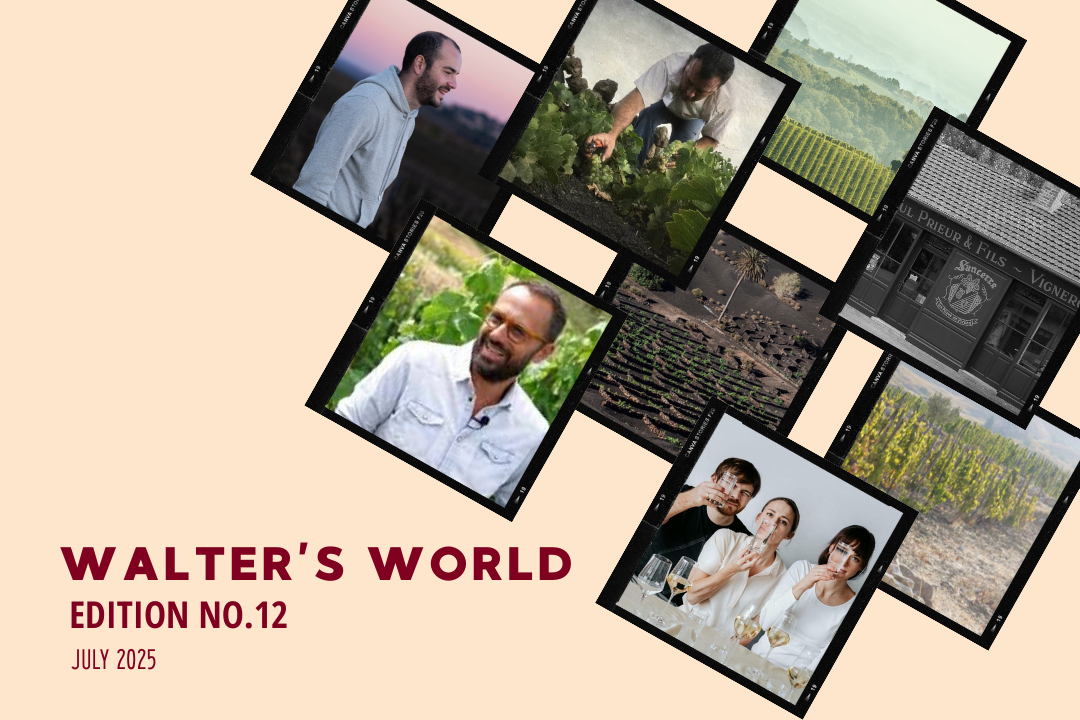Walter's World, Edition No. 12 (July 2025)

Summer is in full swing, and we’ve got refreshing whites and grill-friendly reds in mind. This month, Chris sought out a lineup of distinctive summer wines — selections as rare as they are compelling. Highlights include braided-vine Listán Blanco from some of the oldest vineyards in the Canary Islands, a viticultural tradition as fascinating as the wine itself, and the last little bit of a remarkable Gamay grown in the heart of Pinot Noir country. Thoughtful, expressive, and built for the season, we’re excited for you to discover these alongside us.
Cheers,
the Walter's team
I | Weingut Gross Ehrenhausen
2020 | Sudsteiermark, Styria, Austria | Sauvignon Blanc
Don’t let the name on this one get you, it’s far from gross (thanks to all the Dad’s out there!), in fact this is the exact opposite. It’s so refreshing, vibrant, taut, and packed full of finger limes, sweet herbs, chalk, and alpine mystery. This wine grows in southern Austria, tucked into the foothills of the Alps at elevation, and while the remainder of the country has embraced Grüner Veltliner it is here that Sauvignon Blanc has perhaps found its most exciting home (sorry New Zealand, I still love you though). This is a blend of 4 vineyards in the village of Ehrenhausen and sees a short skin contact to build texture and is aged in large neutral barrels to enrich it without losing the sheer electricity that courses through this wine.
II | Bermejos Maceración Carbónica
2022 | Lanzarote, Canary Islands, Spain | Listán Negro
I know, I know, 2 months in a row with Canary Island wine…..all I can say is that I’m obsessed with these wines for the summer. The ones that really sing to me just transport me to what I’d imagine is a beach house on the black sand beaches of Lanzarote, eating langoustines or whatever sweet little crustaceans abound. The Canaries are closer to Africa than Spain and the climate is extreme for viticulture as the vines struggle in the high winds coming off the Atlantic, so much so that the vineyards look like an artist designed them, with either little craters or mini stone walls to protect them. The soils are black volcanic, forming a stark contrast to the green canopies, and look more like what growing vines on the moon would be. Check out this link to see what I’m talking about, because I know it sounds weird! Listan takes well to carbonic maceration which really helps to build perfume and mitigate tannins so you can absolutely put a little chill on this puppy. With all that perfume this wine would crush with Jamaican or Ethiopian food.
III | Guiseppe Cipolla ‘Solfare’
2023 | Aragona, Sicily, Italy | Grillo & Catarratto
I was poured this wine by our good friend Jon Marvin of Joyous Society who introduced it as “Joey Onion’s” wine from Sicily, inducing a bit of a chuckle after my brain processed what I thought was a joke, but it turned out to be how all of Giuseppe’s English speaking friends lovingly refer to him and he thinks it’s awfully cute. On first sniff I thought it was going to be a hard pass as it didn’t smell like much, but when I took a sip it expanded on my palate at a rapid rate, becoming exponentially more complex and nuanced as I sat with it. This wine takes patience, needing a splash decanting (just turn the bottle upside down like you’re stealing its lunch money) at least 30 minutes before consuming. It’s hard to describe, and would ruin all the fun for you anyway so I’ll refrain for now, but I’d love to chat with you in the shop after you drink it to hear what you think!
IV | Domaine Paul Prieur & Fils Rosé Perpétuel
NV | Sancerre, Loire Valley, France | Pinot Noir
Pinot Noir as rosé is not always my thing, especially from marginal climates like Sancerre, but these days with climate change and better know how in the vineyard, the wines achieve higher phenolic (read: flavor) ripeness without becoming too boozy. Rosé just can’t handle higher alcohol levels as it ruins the refreshing factor we all want. In times past, you had to pick early to avoid the excess sugar, and the wines would be weedy, green, and hard. This one is strawberry-riffic and comes from 11 generations of winegrowers in Sancerre with excellent organic farming. This plot is located at the base of the infamous Mont Damnes hill and is quite old being planted in the 1950s, which is unusual for Pinot Noir to make it this long as 50 years is often expiration age, especially in these more moisture laden climates. This is non-vintage because they’re blending multiple years, similar to what many Champagne producers do to increase complexity. It makes for a pretty serious rosé that can be enjoyed on its own, but really shines with seared salmon belly and salsa verde—if I were making a snack to go with it this weekend, that’d be it.
